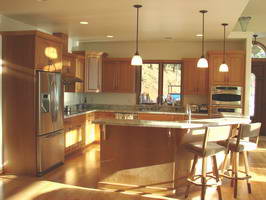How to Wire a Range Hood Exhaust Fan
 '; ';
|
Installing Wiring for a Range Hood Exhaust Fan: Wiring from an Existing Power Source or Outlet, I am wiring a hood exhaust fan over the kitchen range cook top. © By: Dave Rongey |
Wiring a Hood Exhaust Fan
Electrical Question: I am wiring a hood exhaust fan over the kitchen range cook top.
- One of my apartments needs a fan that goes over the stove, it’s a simply fan with light.
- Can I run a electrical wire from a nearby outlet through and in between the wall and to the fan, or do I have to run the electrical wire from the circuit breaker in the basement all the way up to the third floor apartment on the left.
- I am just trying to do it right by the housing code and safe.
Can you please help. Thank you.
This home electrical question came from: Rosa, in Massachusetts.
Additional Comments: Its great and very helpful.
Dave’s Reply:
Thanks for your electrical question Rosa .
How to Install Wiring for a Range Hood Exhaust Fan
A lighted exhaust fan over the cooking stove or free standing range is a great way to add light to the cooking area and help control the spread of cooking odors and grease through the home, and this would be a great weekend project.

Application: Wiring a Range Hood Exhaust Fan.
Skill Level: Beginner to Intermediate. This electrical project is best installed by a Licensed Electrical Contractor or Certified Electrician.
Tools Required: Basic Electricians Pouch Hand Tools and a Voltage Tester.
Estimated Time: Depends on personal level experience, ability to work with tools, access to the power source for the new hood fan. This would be a great weekend project.
Precaution: Identify the existing power source circuit, turn it OFF and Tag it with a Note before working with the wiring.
Notice: Installing electrical wiring for additional outlets should be done according to local and national electrical codes with a permit and be inspected.
Wiring a Range Exhaust Fan From an Existing Power Source or Outlet
- Most conventional hood exhaust fans require 120 volts electrical power and they do not draw a lot of amperage therefore an exhaust fan with a light does not require it’s own circuit, so yes, a wire may be attached to one of the existing wall outlets.
- Be sure to match the new electrical wiring to the existing wiring of the source you choose as the power source.
- Typically a good power source would be a 120 volt receptacle outlet behind the range or a nearby counter top outlet.
- The new cable for the exhaust fan may be directly routed into the junction box location of the fan unit or brought into a junction box inside the upper cabinet above the range or cook top stove where the hood fan will be installed.
More about Wiring a Kitchen Hood Exhaust Fan
- How to Install Kitchen Electrical Wiring

-
Kitchen Electrical Wiring
- Fully Explained Photos and Wiring Diagrams for Kitchen Electrical Wiring with Code Requirements for most new or remodel projects.
- Electric Outlet Wiring
-
Wiring Electrical Outlets for the Home
- Home electrical wiring includes 110 volt outlets and 220 volt outlets and receptacles which are common place in every home. See how wiring electrical outlets for the home are done.
- Guide to Home Electrical Wire Types
-
Electrical Wire for the Home
- Complete listing of electrical wire types and parts used for home projects with electrical code information serves as selection guidelines.
- Home Electrical Wiring Codes
-
Electrical Code Articles for Home Wiring
- Electrical Code Directory covering codes for electrical boxes and electrical circuit wiring.
The following may also be helpful for you:
|
|
Be Careful and Be Safe - Never Work on Energized Circuits!
Consult your Local Building Department about Permits and Inspections for all Electric Wiring Projects.
More articles about Electrical Wiring and Home Electrical Wiring: |
|
| « Previous | Next » |
Wire a Vacuum System for Workshop Tools |
How to Make 120 Volts from 220 Volts |
















